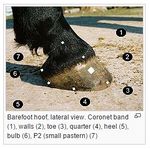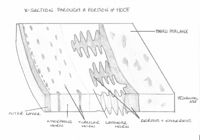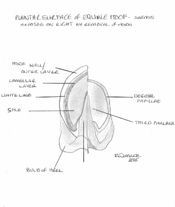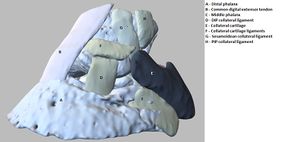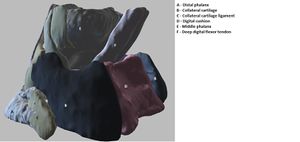Difference between revisions of "Hoof - Anatomy & Physiology"
m |
Fiorecastro (talk | contribs) |
||
| (3 intermediate revisions by 2 users not shown) | |||
| Line 1: | Line 1: | ||
| − | + | ||
==Introduction== | ==Introduction== | ||
The hoof is defined from a physiologic perspective as the modified skin [[Skin - Anatomy & Physiology#Epidermis|(epidermis)]] covering the tip of the digit and all enclosed structures. The hoof provides protection to the distal limb and is formed by keratinisation of the epithelial layer and modification of the underlying dermis. The keratin in the [[Skin - Anatomy & Physiology#Epidermis|epidermis]], when thickened and cornified, is referred to as [[Horn - Anatomy & Physiology|horn]]. Horn makes up the outer surface if the hoof and is particularly resistant to mechanical and chemical damage. | The hoof is defined from a physiologic perspective as the modified skin [[Skin - Anatomy & Physiology#Epidermis|(epidermis)]] covering the tip of the digit and all enclosed structures. The hoof provides protection to the distal limb and is formed by keratinisation of the epithelial layer and modification of the underlying dermis. The keratin in the [[Skin - Anatomy & Physiology#Epidermis|epidermis]], when thickened and cornified, is referred to as [[Horn - Anatomy & Physiology|horn]]. Horn makes up the outer surface if the hoof and is particularly resistant to mechanical and chemical damage. | ||
| Line 51: | Line 51: | ||
==Deeper structures of the foot== | ==Deeper structures of the foot== | ||
| − | [[File:Horse_hoof_wild_bare_sagittal.jpg|thumb|200px|right| | + | [[File:Horse_hoof_wild_bare_sagittal.jpg|thumb|200px|right|Sagittal section through horse hoof.]] |
Enclosed within the hoof capsule are the bony structures – the [[Phalanges_-_Horse_Anatomy#Distal_Phalanx|distal phalanx]], distal end of the [[Phalanges_-_Horse_Anatomy#Middle_Phalanx|middle phalanx]], the [[Joints_and_Ligaments_-_Horse_Anatomy#Distal_Interphalangeal_.28Coffin.29_Joint|distal interphalangeal joint]], and the [[Phalanges_-_Horse_Anatomy#Distal_Sesamoid_.28Navicular.29_Bone|distal sesamoid bone (navicular)]]. There are also soft tissue structures including ligaments, cartilage, the digital cushion and the insertions of the [[Tendons_-_Horse_Anatomy#Thoracic_Limb|common digital extensor tendon]] and the [[Tendons_-_Horse_Anatomy#Flexorsdeep|digital flexor tendon]]. | Enclosed within the hoof capsule are the bony structures – the [[Phalanges_-_Horse_Anatomy#Distal_Phalanx|distal phalanx]], distal end of the [[Phalanges_-_Horse_Anatomy#Middle_Phalanx|middle phalanx]], the [[Joints_and_Ligaments_-_Horse_Anatomy#Distal_Interphalangeal_.28Coffin.29_Joint|distal interphalangeal joint]], and the [[Phalanges_-_Horse_Anatomy#Distal_Sesamoid_.28Navicular.29_Bone|distal sesamoid bone (navicular)]]. There are also soft tissue structures including ligaments, cartilage, the digital cushion and the insertions of the [[Tendons_-_Horse_Anatomy#Thoracic_Limb|common digital extensor tendon]] and the [[Tendons_-_Horse_Anatomy#Flexorsdeep|digital flexor tendon]]. | ||
| Line 58: | Line 58: | ||
The cartilages are securely attached to the other internal structures of the foot by a series of ligaments that extend from the medial and lateral cartilages to the distal and middle phalanx, the [[Phalanges_-_Horse_Anatomy#Distal_Sesamoid_.28Navicular.29_Bone|distal sesamoid bone (navicular)]], and the digital cushion. | The cartilages are securely attached to the other internal structures of the foot by a series of ligaments that extend from the medial and lateral cartilages to the distal and middle phalanx, the [[Phalanges_-_Horse_Anatomy#Distal_Sesamoid_.28Navicular.29_Bone|distal sesamoid bone (navicular)]], and the digital cushion. | ||
| + | |||
| + | [[File:Lateral view hoof internal structures.jpg|thumb|Internal hoof structures]] | ||
===Collateral ligaments.=== | ===Collateral ligaments.=== | ||
The distal interphalangeal joint is enclosed within the hoof capsule. It is stabilised by the medial and lateral collateral ligaments which form part of the joint capsule, connecting the distal end of Pll with the proximal edge of the [[Phalanges_-_Horse_Anatomy#Distal_Phalanx|distal phalanx]]. | The distal interphalangeal joint is enclosed within the hoof capsule. It is stabilised by the medial and lateral collateral ligaments which form part of the joint capsule, connecting the distal end of Pll with the proximal edge of the [[Phalanges_-_Horse_Anatomy#Distal_Phalanx|distal phalanx]]. | ||
| + | |||
| + | [[File:Oblique view.jpg|thumb|Internal hoof structures]] | ||
===Annular ligaments=== | ===Annular ligaments=== | ||
| Line 122: | Line 126: | ||
}} | }} | ||
| − | + | ||
| + | ==Webinars== | ||
| + | <rss max="10" highlight="none">https://www.thewebinarvet.com/herd-health/webinars/feed</rss> | ||
{{review}} | {{review}} | ||
[[Category:Integumentary System - Anatomy & Physiology]] | [[Category:Integumentary System - Anatomy & Physiology]] | ||
[[Category:A&P Done]] | [[Category:A&P Done]] | ||
Latest revision as of 14:16, 9 January 2023
Introduction
The hoof is defined from a physiologic perspective as the modified skin (epidermis) covering the tip of the digit and all enclosed structures. The hoof provides protection to the distal limb and is formed by keratinisation of the epithelial layer and modification of the underlying dermis. The keratin in the epidermis, when thickened and cornified, is referred to as horn. Horn makes up the outer surface if the hoof and is particularly resistant to mechanical and chemical damage.
Each epidermal region of the hoof is associated with a dermal region (corium). The corium are connected to the underlying structures by the subcutis. As the foot can be divided into 5 segments – Wall, coronary, periople, sole, and frog – there are 5 corresponding underlying corium.
The origin of the hoof is as a form of protection to the distal phalanx and stems from local modifications of the epidermis, dermis and subcutaneous layers. There is great variation in the shape and types of hooves across different species and this is often due to the multi-role nature of the hoof. In some species the hoof may play an important role in non-locomotion roles such as digging or being used as a weapon. The hoof also acts as a shock-absorber in that the hoof acts to reduce the concussion of foot impact on the structures of the distal limb. It has also been suggested in some species that the elastic nature of components of the hoof may aid the return of blood to the heart. The following information relates primarily to the horse hoof.
Five Segments of the Hoof
Wall
The wall of the hoof is the element of the hoof that is visible. The wall forms the medial, lateral and dorsal aspect of the hoof and it can be further divided into the toe, quarters and heels. At the heel the walls reflect back on themselves at a point called the angles and in doing so forms the bars. The bars, although moving cranially, gradually fade along the edge of the frog and never actually meet. The wall of the hoof is widest at the distal aspect of the hoof, i.e. at the toe. The wall of the hoof decreases in width laterally and medially (around the quarters of the hoof). In most domestic species the wall of the hoof is between 5 - 10mm thick and consists of three layers. There is an outer layer of thin but dense horn that is shiny and acts to reduce evaporation from the horn and therefore prevent dehydration of the other layers of the horn – the periople. There is an intermediate layer which represents the main structure of the wall and is composed of amorphous horn reinforced with many tubular shaped horn rods. Finally, there is an inner laminar layer where there are interdigitating laminae of horn and dermal laminae which ensure the hoof itself is firmly anchored to the distal phalanx. The bond between the horn and the underlying dermis is a living bond that gradually allows the wall of the hoof to slide in a distal direction towards the ground where the distal border is worn away via contact with the ground. Attached by the subcutis to the periosteum of the distal phalanx, the laminar corium suspends the entire weight of the animal by the distal phalanx within the hoof capsule via microscopic interdigitations with the epidermal laminae of the hoof wall. Damage to the vasculature of the laminar corium can result in compromises in the integrity of the interdigitations.
The hooves in newborn foals are bilaterally symmetrical. Over a period of just a few months, forces exerted on the hoof during locomotion cause a visible difference between the right and left, as well as front and hind hooves. Thus, isolated specimens of equine feet can be distinguished as follows:
Front vs hind: Front: The angle between the toe and the ground is approximately 45 degrees. The sole is circular in shape. Hind: The angle between the toe and the ground is 50-55 degrees. The sole is oval in shape.
Right vs left: Quarters (lateral and medial walls) are steeper on the medial side of the hoof. Assessment of the external anatomy can be a used as an important part of a lameness examination.
Periople
The periople is a small band of soft tissue found over the proximal surface of the wall of the hoof. The periople represents the junction between the wall and the skin of the limb. The periople is responsible for the production of the outer layer of the wall (above). The periople segment extends around the proximal edge of the wall and in horses covers the bulb of the heel and part of the frog. In ruminants it forms part of the join between both hooves of the foot. The perioplic corium, proximal to the coronary band and continuous with the skin, it produces the thin, shiny layer (stratum externa) of the hoof wall.
Coronary Segment
The wall of the hoof is created at the coronary dermis and grows in a distal direction from the coronary dermis. The coronary dermis is studded with many papillae which are directed towards the ground in the direction of growth. The epidermis covering these papillae produce horn tubules which are embedded into amorphous inter-tubular horn. This inter-tubular horn is created by the spaces between the papillae within the coronary dermis. The combination of both of these horn types ensures the horn has sufficient strength.
The pigmentation of the hoof is derived from melanocytes found in the coronary epidermis. Any pigmentation in the hoof will be most pronounced in the outer part of the hoof wall as the deeper layers of the hoof usually contain fewer melanocytes. It is this unpigmented element of the hoof that forms the 'white line' in the sole of hoofs and is particularly important in horses as a landmark for shoeing.
The coronary corium is responsible for the growth of the bulk of the tubular and non-tubular horn that make up the hoof wall. This wall glides distally at a rate of 5-6mm a month and by forming epidermal laminae itself it interdigitates with the underlying dermal laminae. Neither of these laminae are pigmented so when the epidermal laminae appear on the solar surface, a non-pigmented region known as the white line appears. The white line is used as important landmark in farriery as structures central to the line will be dermal and so vascular and sensitive. Interruptions in the coronary corium can result in defective hoof wall growth.
Sole Segment
The sole is the area distal to the bars and apex of the frog enclosed by the hoof wall. The area where the bars and wall enclose it is known as the angle of the sole. Since the sole is slightly concave, the majority of the horse's weight is transferred through the margin of the sole.
The sole represents the part of the foot in contact with the ground and its composition differs between species. The keratin found in the sole is formed from the epidermis on the underside of the third phalanx and can grow to a thickness of around 10mm in domestic species. The keratin found on the sole is much more easily worn down or abraded than that of the wall of the hoof. The equine sole has a central frog structure whilst ruminants and pigs have a bulb structure to the sole.
The solar corium is the dermal layer underlying the solar surface that produces a superficially flaky epidermis. Sufficient solar depth is necessary to protect the underlying soft tissue and bony structures.
Frog-Bulb Segment
The frog is a wedge-shaped structure which sits between the bars and has an apex facing distally, with 2 crura flanking a central sulcus. Between the crus and bar of each half of the sole lies the collateral sulcus. Opposite the apex, the frog expands forming the bulbs of the heel. The frog is a mass of keratinized stratified squamous epithelium, which is softer than other parts of the hoof due to its increased water content. Usually, the frog contributes to the weightbearing surface where it functions as a shock absorber. Apocrine glands within the corium of the frog produce secretions on the surface. The frog ensures that the wall of the hoof is forced outwards when weight is put on the limb thus ensuring that the 'hoof mechanism' functions correctly and ensuring circulatory flow around the hoof and back towards the heart. The ruminant/pig 'bulb' provides the hoof with the caudal and mid-hoof contact area with the ground and is chiefly involved in weight bearing. The bulb inserts into the V-shaped sole. The bulb is made of relatively soft material, mainly inter-tubular horn and is of a considerable thickness.
The frog corium overlies the digital cushion and generates the specialised soft epidermal tissues of the frog.
Deeper structures of the foot
Enclosed within the hoof capsule are the bony structures – the distal phalanx, distal end of the middle phalanx, the distal interphalangeal joint, and the distal sesamoid bone (navicular). There are also soft tissue structures including ligaments, cartilage, the digital cushion and the insertions of the common digital extensor tendon and the digital flexor tendon.
Ungual (collateral) cartilages
The ungual cartilages are extensions of the distal phalanx (Plll) that extend caudally and dorsally from the medial and lateral margins of the distal phalanx, curving inwards towards each other in the heel region. The cartilages extend just beyond the confines of the hoof capsule making them palpable just above the coronary band at the lateral and medial edges of the foot. The ungual cartilages can ossify resulting in ‘side bones’ which have the potential for fracturing. The cartilages can also become infected resulting in the condition known as ‘quittor’.
The cartilages are securely attached to the other internal structures of the foot by a series of ligaments that extend from the medial and lateral cartilages to the distal and middle phalanx, the distal sesamoid bone (navicular), and the digital cushion.
Collateral ligaments.
The distal interphalangeal joint is enclosed within the hoof capsule. It is stabilised by the medial and lateral collateral ligaments which form part of the joint capsule, connecting the distal end of Pll with the proximal edge of the distal phalanx.
Annular ligaments
The annular ligament has its origins on the medial and lateral surfaces of distal Pl. It is the most superficial structure in the region, lying just beneath the skin and fusing with the digital flexor tendon where it enters the hoof capsule. Once inside the hoof the annular ligament merges with the fibrous attachments of the ungual cartilages and digital cushion, and continues with the digital flexor tendon down to its insertion onto the distal phalanx.
Sesamoidean ligaments
The dorsal border of the distal sesamoid bone (navicular) is held securely to the palmar/plantar surface of the distal phalanx by the distal sesamoidean ligament and to the proximal phalanx via the proximal interphalangeal collateral ligaments by means of a pair of medial and lateral collateral sesamoidean ligaments.
The distal sesamoid bone (navicular) lies between the middle and distal phalanges and the deep digital flexor tendon. Associated with it is a fluid-filled sac that reduces friction between the bone and the digital flexor tendon that lies over the top of it— the navicular bursa. Inflammation in the region is involved in navicular disease which is a common cause of lameness.
Digital Cushion
The digital cushion is the internal tissue deep to the frog. It lies between the ungual cartilages and is comprised of collagenous, elastic tissue infiltrated by adipose tissue. At the bulbs of the heel, it is subcutaneous and is soft and loose in texture. It has connection with the digital annular ligament and, at the apex to the deep digital flexor tendon at its point of insertion on the distal phalanx. It acts as one of the major shock absorbers of the foot. When the limb is weight bearing, the increase in pressure and change in shape of the digital cushion and the frog compress the veins in the foot aiding venous return.
Blood supply to the digit
The main vessels supplying the digit in the forelimb are the medial and lateral palmar digital aa, both of which arise from the median a. In the digit of the hind limb the medial and lateral digital aa. are a continuation of the metatarsal a. and are also contributed to by the medial and lateral plantar aa. which branch from the sapheneous a. The digital arteries give rise to numerous branches forming rich networks for the vascular tissues. Many anastomoses occur. The terminal branches of the main vessels finally enter a bony canal in the distal phalanx. Venous drainage is similar with the most distal vessels being the medial and lateral palmar/plantar digital veins. The compressive action of the hoof on the soft tissues within during locomotion generates an important function promoting venous return.
Normal equine digital vasculature anatomy can be divided into five major areas of perfusion: 1. Coronary plexus 2. Dorsal lamellar plexus 3. Circumflex vessels 4. Terminal arch 5. Heel perfusion. Loss of perfusion to the lamella vessels, circumflex vessels, and terminal arch indicates a poor prognosis without aggressive therapy.
Microcirculation in the dermal laminae
Numerous arteriovenous anastomoses occur which are of a somewhat unusual type. Under normal circumstances these are closed and as a result circulation within the capillary beds of the dermal laminae occurs. Certain systemic pathologies may result in opening of these AV anastomoses resulting in ischaemia of the laminae. This in turn results in the hoof wall separating from the distal phalanx producing the disease termed “laminitis”, which can be either acute or chronic.
Innervation of the equine digit
The digit of the forelimb is innervated by the medial and lateral digital nerves. The medial digital n. is a continuation of the median n. and the lateral digital n. is derived from both median and ulnar nerves. These run on the palmar aspect of the digit in close proximity to the main arteries and veins. They give rise to several dorsal branches which supply dorsally located areas.
The pelvic limb digit is innervated on the dorsal aspect by the common digital nn. Derived from the fibular n. The plantar aspect is innervated by the medial and lateral digital nn which originate from the tibial n. In addition to their normal importance in supplying innervation to the sensitive tissues of the equine digit these nerves are also of considerable clinical importance as they are utilized for the procedure termed diagnostic nerve blocks.
Species variation
Ruminant Hoof
The ruminant hoof, although resembling the equine hoof in some characteristics, differs from the equine hoof in several ways. In the ruminant hoof there are two separate main digits and the wall of the hoof is bent to form a border. Also the bulb of the heel covers the entire caudal surface of the hoof and most of the plantar surface, leaving only a small area of sole visible. In ruminants the interdigitating lamellae are smaller and less well developed than in equids.
The hooves of the main digits curve medially towards each other. The lateral digit carries more weight than the medial digit, and is larger. On the abaxial wall, the distal border makes contact with the ground along its entire length, whereas, on the axial wall, only does so toward the toe. The thickness of the wall increases towards the apex and the plantar surface. The horn of the hoof generally grows at a rate of 5 mm per month, and in cattle allowed to move freely, growth should equal wear. In intensively kept cattle, growth exceeds wear, and foot trimming is required to maintain optimal shape and angle. The optimal angle of the toe from the ground is 50 degrees. Where horn overgrowth occurs, the coffin joint is gradually overextended and the deep flexor tendon tensed. This results in greater weight being placed over the caudal part of the hoof and can cause pain and lameness.
Dewclaws are present in most ruminants but do not make contact with the ground. They consist of wall and bulb and have no practical importance.
See the bovine lower limb for further detail.
Porcine Hoof
The hooves of pigs are principally similar to those of ruminants, however the wall is straight, not bent medially at the toe, and they have a soft bulb that is well distanced from the wall and sole. The hooves of the accessory digits are of the same structure as the principal digits, but only bear weight on soft ground.
Hoof trimming in pigs is rarely required due to the short lifespan of the farmed pig.
| Hoof - Anatomy & Physiology Learning Resources | |
|---|---|
 Test your knowledge using flashcard type questions |
Hoof Flashcards |
 Full text articles available from CAB Abstract (CABI log in required) |
The growth and adaptive capabilities of the hoof wall and sole: functional changes in response to stress. Bowker, R. M.; American Association of Equine Practitioners (AAEP), Lexington, USA, Proceedings of the 49th Annual Convention of the American Association of Equine Practitioners, New Orleans, Louisiana, USA, 21-25 November 2003, 2003, pp 146-168, 32 ref. Contrasting structural morphologies of "good" and "bad" footed horses. Bowker, R. M.; American Association of Equine Practitioners (AAEP), Lexington, USA, Proceedings of the 49th Annual Convention of the American Association of Equine Practitioners, New Orleans, Louisiana, USA, 21-25 November 2003, 2003, pp 186-209, 73 ref. |
Anatomy Museum Resources |
White Line of Bovine Hoof Bovine Hoof Wall |
Webinars
Failed to load RSS feed from https://www.thewebinarvet.com/herd-health/webinars/feed: Error parsing XML for RSS
| This article has been peer reviewed but is awaiting expert review. If you would like to help with this, please see more information about expert reviewing. |
